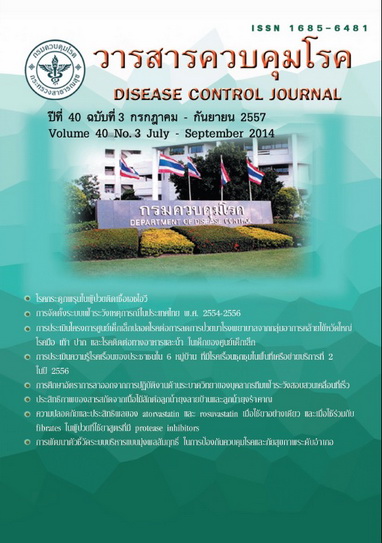The establishment of event-based surveillance system in Thailand, 2011-2013
DOI:
https://doi.org/10.14456/dcj.2014.10Keywords:
event, surveillance, guideline, ThailandAbstract
Factors leading to the establishment of an event-based surveillance system include new paradigm of the International Health Regulations (IHR 2005) requirements, advances in Information Technology and increased amount of information sharing among the general public. The new system aims at rapid detection of and response to emerging threats while the old one (the so-called indicator-based surveillance system) aims at monitoring the performance and impact of disease control programs. Event-based surveillance systems can be divided into three categories: (1) news aggregator (2) automated type and (3) moderated type. Thailand has been implementing a moderated type system. In 2009, it was determined that surveillance of events would be part of the standard competency of Surveillance and Rapid Response Teams (SRRTs) in Thailand. Subsequently a training of the trainer program was implemented in 2010. Then during 2011-2012, members of sub-district SRRTs, mostly being village health volunteers (VHVs), were trained to report relevant events which occurred in their villages. The event-based surveillance manual for VHVs and the guidelines for members of SRRTs were made available in 2011 and 2013 respectively. The guidelines give details on objectives, definitions, informants development, event reporting, and system processes (capture, filter, verify, signal identification, assessment and response). There is a need to evaluate the effectiveness of the system and operational processes, and to further develop an automated event-based surveillance system.
Downloads
References
2. ดารินทร์ อารีย์โชคชัย, ฐิติพงษ์ ยิ่งยง, ธราวิทย์ อุปพงษ์, เสาวพักตร์ ฮิ้นจ้อย, วัชรี แก้วนอกเขา, สมเจตน์ ตั้งเจริญศิลป์, และคณะ. แนวทางการรายงานโรคที่มีความสำคัญสูง ประเทศไทย. กรุงเทพมหานคร: ชุมนุมสหกรณ์การเกษตรแห่งประเทศไทย; 2555.
3. ปภานิจ สวงโท, วัชรี แก้วนอกเขา, สมาน สยุมภูรุจินันท์, ธราวิทย์ อุปพงษ์. สถานการณ์ไข้เลือดออก ไข้เลือดออกช็อก และไข้เดงกี ประเทศไทย. รายงานการเฝ้าระวังทางระบาดวิทยา ประจำสัปดาห์ 2554;42:481-5.
4. World Health Organization, Western Pacific Region. A Guide to establishing event-based surveillance [Internet]. 2008 [cited 2012 Apr 5]. Available from: http://www.wpro.who.int/internet/resources.ashx/CSR/Publications/eventbasedsurv.pdf
5. วันชัย อาจเขียน, นิภาพรรณ สฤษดิ์อภิรักษ์, ทิพยา เผื่อนพิภพ, อำนวย ทิพศรีราช, ศิริพร วัชรากร, พิมพ์ผกา นิศาวัฒนานนท์, และคณะ. มาตรฐานและแนวทางปฏิบัติงานทีมเฝ้าระวังสอบสวนเคลื่อนที่เร็ว (SRRT). กรุงเทพมหานคร: ชุมนุมสหกรณ์การเกษตรแห่งประเทศไทย; 2552.
6. European Center for Disease Prevention and Control. Surveillance of communicable diseases in the European Union, a long-term strategy: 2008-2013 [Internet]. 2008 [cited 2012 Apr 5|. Available from: http://www.ecdc.europa.eu/en/aboutus/keydocuments/08-13_kd_surveillance_of_cd.pdf
7. Agheneza T. A systematic literature review on even-based public health surveillance systems [Internet]. 2011 [cited 2012 Apr 201. Available from: http://edoc.sub. uni-hamburg.de/haw/volltexte/2012/1614/pdf/lsabl2_27.pdf
8. Pollack MP. ProMED TEPHINET Collaboration [Internet]. 2013 [cited 2014 Mar 23]. Available from: http://www.emphnetconferences.net/images/conference1/ presentations/6th-5-ProMEDTEPHINETCollaborationv.2a.pdf
9. Brownstein JS, Freifeld cc, Madoff LC. Digital Disease Detection-Harnessing the Web for Public Health Surveillance. N Engl J Med [Internet]. 2009 May [cited 2014 Mar 23]; 360:2153-57. Available from: http://www.nejm.org/doi/pdf/10.1056/NEJMp0900702
10. วันชัย อาจเขียน. วิทยาการระบาดในการเฝ้าระวังและสอบสวนโรค.ใน: ศรีศักดิ์ สุนทรไชย, บรรณาธิการ. ประมวลสาระชุดวิชาวิทยาการระบาดประยุกต์กับการพัฒนาสุขภาพและสิ่งแวดล้อม หน่วยที่ 1-7. นนทบุรี: มหาวิทยาลัยสุโขทัยธรรมาธิราช; 2553. หน้า. 7-1 ถึง 7-85.
11. วรรณา หาญเชาว์วรกล, ปิยนิตย์ ธรรมาภรณ์พิลาส, ชุลีพร จิรพงษา, จารุนีย์ กุมภลำ, พรรณราย สมิตสุวรรณ, สำเริง ภู่ระหงษ์. หน่วยสอบสวนกลางทางระบาดวิทยา บทเรียนหนึ่งปีสำหรับการควบคุมการระบาดในอนาคต. วารสารวิชาการสาธารณสุข 2546;12:117-23.
12. วันชัย อาจเขียน, เฉวตสรร นามวาท, โสภณ เอี่ยมศิริถาวร, นิภาพรรณ สฤษดิ์อภิรักษ์, ชุลีพร จิระพงษา, พจมาน ศิริอารยาภรณ์, และคณะ. คู่มือเฝ้าระวังเหตุการณ์และควบคุมโรคระบาดในชุมชน. พิมพ์ครั้งที่ 4. กรุงเทพมหานคร: องค์การสงเคราะห์ทหารผ่านศึก; 2555.
13. วันชัย อาจเขียน. แนวทางปฏิบัติงานเฝ้าระวังเหตุการณ์ระดับตำบล. ใน: นิภาพรรณ สฤษดิ์อภิรักษ์, บรรณาธิการ. แนวทางการดำเนินงานเฝ้าระวังเหตุการณ์ของ SRRT เครือข่ายระดับตำบล. กรุงเทพมหานคร: ชุมนุมสหกรณ์การเกษตรแห่งประเทศไทย; 2555. หน้า. 1-24.
14. Pollack MP. Introduction to informal information sources for disease surveillance systems. Pilot training on integrating informal information as a source for reporting unusual disease occurrences to surveillance system; 2009 November 13; Bangkok, Thailand. Nonthaburi: Bureau of Epidemiology MOPH-Thailand; 2009.
Downloads
Published
How to Cite
Issue
Section
License
Articles published in the Disease Control Journal are considered as academic work, research or analysis of the personal opinion of the authors, not the opinion of the Thailand Department of Disease Control or editorial team. The authors must be responsible for their articles.






